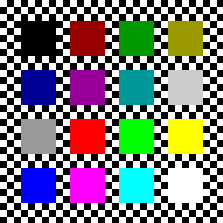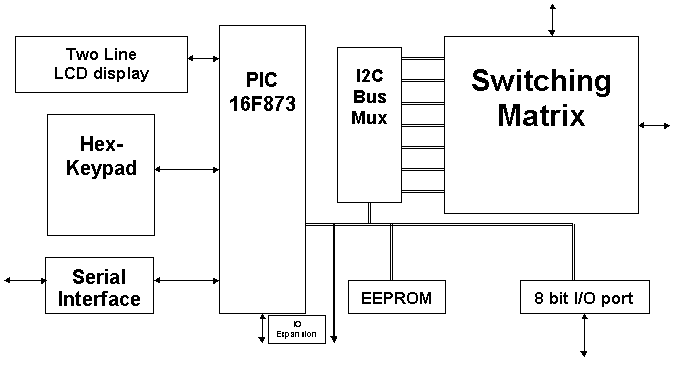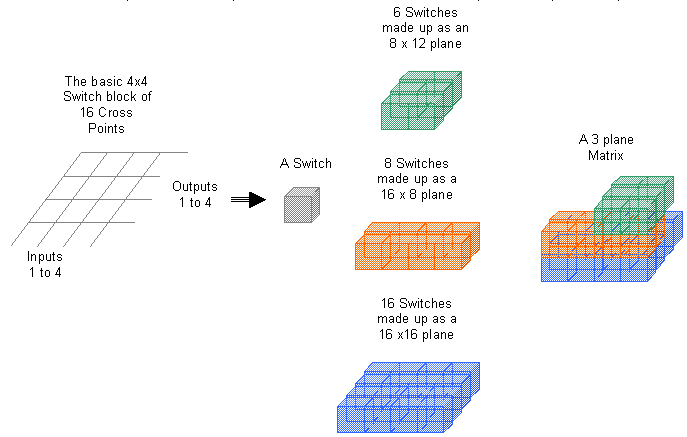
 |
Description | Article from CQ-TV | PC Software | |
| Keypad Interface | Serial Interface | Circuits | ||
| Ordering | Documentation | Contacts | ||
| Connecting | ||||
| The MATRIX | ||||
This article was submitted to the BATC for publication in CQ-TV 194 during March 2001
The MATRIX – A versatile switching solution
By Geoff Mather G8DHE
Introduction
Over the years since the introduction of video repeaters the complexity of both repeaters themselves and the average station has increased dramatically. Originally we often only had a couple of video sources, perhaps a couple of monitors and a single transmitter to worry about and the linking between these devices could be handled with no more than half a dozen cables. In contrast a recent count of sources and sinks in my own shack totalled 15 sources and 18 sinks for video alone, several of these had matching stereo sound sources as well.
Our repeater site (Worthing Video Group - GB3VR-GB3RV) has a planned 20 video sources, 11 video sinks, 13 audio sources, 11 audio sinks, 17 data sources and 11 data sinks. Which has lead us to the inevitable conclusion that we have a SWITCHING PROBLEM!
What do we need ?
In asking around the local area I have decided that we all need something slightly different. Also that no matter what we think is large enough now, in a couple of years time we will come to the conclusion that it wasn’t quite right either in size or shape. So the first requirement is a flexible size of switching array, and more than a single array is required in order to meet all requirements.
The next question is how should it be controlled? A simple keypad is nice, but it doesn’t lend itself to the more complex re-arrangements that are sometimes required.
Obviously some form of memory capacity would allow rapid switching between defined states, but there is a limit to the number of memories that can be stored or documented so that we can choose between them. So a more complex driving device will be needed in some situations, but that shouldn’t be at the cost of a simple interface.
For use on repeaters then remote computer control is a definite requirement, so some form of serial or parallel interface is needed to allow interface to the existing controlling computers.
Switching Structure
In looking around the possible devices that would allow switching of both video and other types of signal sources it became clear that there were two main choices. First the common form of multiplexer or crosspoint switches, typified by the Maxim range of devices, which give great flexibility but some rather significant challenges when it comes to controlling more than a few devices. The second are the dedicated switches from the likes of Mitel who have a great range of sizes but a price range suited to the professionals! Also the number of current devices that work in analogue mode rather than using digital streams is now beginning to become a problem. The devices most suitable that I have discovered are those intended for domestic TV source switching such as TEA5116, TEA6145 etc however they have a limited number of sources and again a difficult mode of control if you need to use several devices in an array. My final choice came down to the Philips TDA8540 device which is an I2C controlled device with 4x4 crosspoint and buffering however even this has an apparent limit of seven devices, which would not be sufficient to handle the envisaged size without some extra help, which is now, fortunately, available.
Implementation
T
he design has finalised on a PIC 16F873 processor, a two line LCD display, Hex keypad, serial interface and an 8 bit I/O port. The processor board also has 2Kbytes of CMOS EEPROM for memory storage. The interface to the switching matrix is via an I2C bus and to enable the use of more than 7 TDA8540 devices, the I2C bus is multiplexed via a number of PCA9544 devices which allow one bus to be expanded to 4 buses. The overall block diagram is shown in Fig. 1.
Fig. 1
The switching matrix itself has been designed to be very flexible, with the software taking the strain in terms of the shape and number of independent switching planes, Figure 2. Shows the way that the switching is implemented.

Fig. 2
In the current design the overall limits to the size and shape of the matrix are;
There can not be more than 224 (4*4) Switches in the entire matrix.
No single plane can have more than 100 inputs or 100 outputs.
That there cannot be more than 186 outputs across all the planes if the full complement of 10 memories are required.
A maximum of 10 planes.
Progress
To date a prototype of both the controller and switching matrix has been constructed and the software is being developed at the present time, Feb. 2001, see Figure 3. The controller board will be identical for any size of switching matrix, and possibly the basis for a number of other projects as well.
The actual switching matrix has been designed around a basic board size of 16x16 I/O’s but the board need not be fully populated and can be cut down if necessary. Multiple boards can be used either to extend the size of a single plane or to add additional planes to the matrix.
A kit ?
If there is sufficient demand then it is possible that a kit will be produced. However as the boards use surface mount devices I am not sure at this stage if sufficient people would be interested, as many builders seem to be put off rapidly when it comes to using SMD’s. This has been my own first experience of using SMD’s in any quantity and I have not found it to be a massive problem (despite using varifocal glasses!).
Given the flexibility of the design it is not practical at this stage to give any firm cost figures other than to say that the target price is between £100-£200 for a 3 plane 16x16 matrix.

Another factor is the availability of the Phillips PCA9455 I2C Bus multiplexer devices, these are a fairly new device which seems impossible to source via any of the UK or European distributors. American sources are available but seem unwilling to ship to the UK, time to find a W* colleague (or anyone else!) to assist I think?
Demo at the BATC rally
It is hoped that the prototype will be on display on the Worthing Video Group stand in May, where you can register any interests in a kit.
Geoff Mather G8DHE